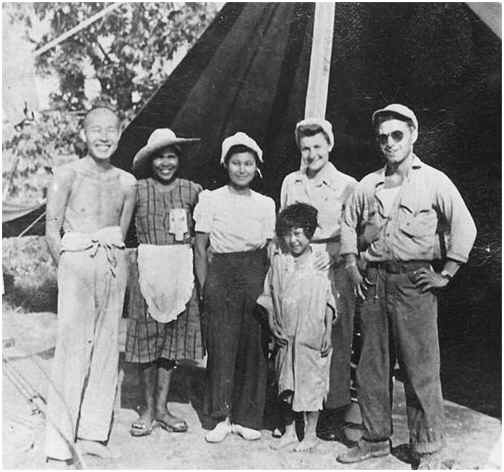via Boing Boing by Futility Closet

Guy Gabaldon was an untested Marine when he landed on the Pacific island of Saipan during World War II. But he decided to fight the war on his own terms, venturing alone into enemy territory and trying to convince Japanese soldiers to surrender voluntarily. In this week's episode of the Futility Closet podcast we'll follow Gabaldon's dangerous crusade and learn its surprising results.
Continue reading
=============================
via An Awfully Big Blog Adventure by Anne Rooney

Happy Birthday, Mr Pepys
A couple of weeks ago I went to Samuel Pepys’ birthday lunch. He would have been 384, so couldn’t make it, being unavoidably detained by death. Pepys kept a famous diary during the 1660s in which he recorded his daily life and the great events of the day, including the Great Plague of 1665-6 and the Great Fire of London in 1666. He was a member of the Royal Society and knew the influential people of his day – scientists, writers, politicians and so on. His lunch comprised six different courses, each one something he actually ate, with six different wines. Then there was music arranged by his house-musician (oh, to have your own house musician!) and a visit to his library.
Continue reading
=============================
via Interesting Literature
An introduction to a classic play
Michael Billington notes in The 101 Greatest Plays: From Antiquity to the Present that Aeschylus’ classical play The Persians is the oldest surviving work of Western drama. First performed at the City Dionysia in 472 BC, The Persians takes a nuanced approach to the matter of war and conquest. It was a direct inspiration for the French national anthem, ‘La Marseillaise’. Percy Shelley’s drama Hellas was written in response to it. It’s the only play from the classical era that deals with historical events rather than mythological ones. In short, The Persians is a fascinating play and Aeschylus’ handling of war is worthy of closer inspection and analysis.
Continue reading
=============================
via OUP Blog by Anatoly Liberman

“la Godivelle : stained glasses the ‘Saint-Blaise’ in the church corbels (Puy-de-Dôme, France)” Photo by Romary, CC BY 2.5 via Wikimedia Commons.
Why Tom, Dick, and Harry? Generic names? If so, why just those? From Suffolk to Yorkshire people speak about some Laurence and some Lumley, whose fame rests only on the fact that both have alliterating lazy dogs (as lazy as L.’s dog, as laid him down to bark). Other farmers had worse luck. Consider all in a heap like Brown’s cows. What happened to Mr. Brown’s cattle to make their case proverbial? I am afraid no one will ever be able to enlighten us. Perhaps Mr. Brown and his animals never existed, so that the owner of the smitten kine belongs with the concerned but unnamed parent in Sam Weller’s pronouncement: “Out vith it, as the father said to his child who swallowed a farden.” But one never knows.
Continue reading
=============================
via 3 Quarks Daily by Scott F. Aikin and Robert B. Talisse
Wisdom is a product of experience and reflection. As a consequence, it’s often quite a long road to that goal. It’s for this reason that the poetic expression, “the Owl of Minerva Flies at Dusk”, has its effect. Only at the end of the day, once the work is done and we recline in thought, do the insights of what we ought to have done, what the best option was, and what was wrong about a particular decision become clear. We live forward, but we understand backward. And that can occasion distinctive problems.
Continue reading
=============================
via the Guardian by Aaron Hicklin

Born to dance: Copeland’s story is, for millions of Americans, an archetypal story of triumph over adversity. Photograph: Danielle Levitt for the Observer
We cannot know whether Misty Copeland would have become America’s most celebrated ballet dancer if she had not met Cindy Bradley, the flame-haired instructor who first recognised and then sharpened her talents, but it seems unlikely. Then again, it’s doubtful that Copeland would have met Bradley if not for Elizabeth Cantine, the coach of her school drill team who urged her to check out the free ballet class at the Boys & Girls Club of San Pedro. Nor is it clear that Copeland would have joined Cantine’s squad without the encouragement of her adored older sister, Erica, a drill team star. It was Erica who helped Copeland choreograph an audition piece to George Michael’s I Want Your Sex. And who, knowing her story, can omit the Romanian gymnast Nadia Comaneci from this roll call? As a seven-year-old, trying to emulate Comaneci’s pyrotechnics, Copeland instinctively understood “that rhythmic motion came as naturally to me as breathing,” to quote from her memoir, Life in Motion.
Continue reading
=============================
via 3 Quarks Daily: Rebecca Tuhus-Dubrow in The Nation

Jane Jacobs in 1961. (World-Telegram & Sun photo by Phil Stanziola. Courtesy of the Library of Congress)
In 1956, Jane Jacobs was 39 years old, working as a staff writer at Architectural Forum. Her boss, unable to attend a conference at Harvard, asked her to go in his stead and give a talk on land banking. Jacobs, skittish about public speaking, reluctantly agreed, on one condition: that she could speak on a subject of her choice.
That subject, it turned out, was the utter wrongheadedness of many of the ideas cherished by her audience, the era’s luminaries of urban planning. The prevailing wisdom at the time held that “urban renewal” required clearing “slums” and starting over. The rebuilt cities would tidily disentangle residential and commercial areas and include plenty of open space. These ideas may have looked good in architectural drawings, but in real life, Jacobs had come to believe, they were a formula for lifeless monotony.
Continue reading
=============================
via Arts & Letters Daily: Jules Smith in Times Literary Supplement

Jack Kerouac, 1952 © Carolyn Cassady/Writer Pictures
In February 1950, Jack Kerouac made a note of his “wish to evoke that indescribable sad music of the night in America – for reasons that are never deeper than the music”. This aspiration sounded throughout his later writings; at the outset of Mexico City Blues (1959), the only major collection of poems published in his lifetime, he declared himself “a jazz poet blowing a long blues”. He wanted musicality in his 1950s novels, experimental prose poetry and the self-invented free form haikus he called “American Pops”. The elegiac passages concluding On the Road (1957) and “October in the Railroad Earth” have long been celebrated for the flowing rhythmic beauty of their wordplays. But his modern jazz-inspired improvisational poetics took far longer to gain recognition, even though his friends Allen Ginsberg and Michael McClure, and the youthful Bob Dylan, were early advocates for Mexico City Blues, the latter calling it “the first poetry that spoke my own language”.
Continue reading
=============================
via Boing Boing by Mark Frauenfelder
Primitive Technology is a YouTube video channel produced by an Australian guy who goes into the jungle with nothing but the clothes on his back, and makes things like shelters, tools, and weapons. There are no words or text in the video, only the sounds of nature for a soundtrack. Here's his latest video.
Continue reading and then watch
=============================
via Big Think by Paul Ratner
Yes, there is an image, I have not copied it out of respect for those with a phobia.
Who are the world’s top predators? It’s not humans, killer whales or tigers. The creatures that kill and consume the most amount of prey per year are lowly spiders. Such is the conclusion of illuminating research by a Swiss spider scientist.
Continue reading
No comments:
Post a Comment